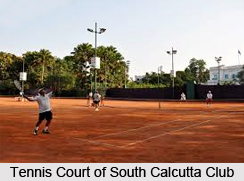 Calcutta South Club is a non governmental autonomous club in Kolkata, which is responsible for many nation based tournaments.
Calcutta South Club is a non governmental autonomous club in Kolkata, which is responsible for many nation based tournaments.
Location of Calcutta South Club
Calcutta South Club is located in Woodburn Park Road of Kolkata. It is a venue for lawn tennis. Davis cup matches are held here. It is in Bhawanipore locality of South Kolkata.
Training Centre of Calcutta South Club
Calcutta South Club is also tennis training centre.
Establishment of Calcutta South Club
Calcutta South Club was established in 1920. The club is known as the cradle of the game (lawn tennis) in India and Kolkata as well. The first Grass Court National Championship of India was held at South Club in 1946.
Foundation of Calcutta South Club
Calcutta South Club was founded all the way back in 1920 with just a single grass court to its name. Over the decades, the club has made steady progress and now boasts six grass, six red clay and five synthetic hard courts, making it one of the few clubs in India to possess all three playing surfaces.
Management of Calcutta South Club
In 1929, with the tireless efforts of the management of Calcutta South Club, the first visit of a foreign team to India could take place. The French team of Henri Cochet, Jacques Brugnon and Jean Borotra played to a full house at the club when they visited Kolkata after touring Japan, which was the first world-class tournament played. This quiet start led to subsequent visits from the likes of Bill Tilden, Jaroslav Drobny, Jack Kramer, Lew Hoad, Ken Rosewall, Pancho Segura, Tony Trabert, Frank Sedgman, Roy Emerson, Fred Stolle, Ashley Cooper, Andres Gimeno, Alex Olmedo, Manuel Santana, Alex Metreveli, Illie Nastase and Ion Tiriac.
Calcutta South Club in Modern India
Calcutta South Club lost its importance after the Independence of India. Calcutta South Club started holding all the tournaments of India soon after its inception. The tournaments that is responsible for the world class tournaments Calcutta South Club, after the independence of India in the year 1947 is known as the Calcutta Lawn Tennis Championships. In due course, this assumed the form of the National Championship of India.
Related Articles
Kolkata
Culture of Kolkata
History of Kolkata
Economy of Kolkata
West Bengal
Tourism In Kolkata



















